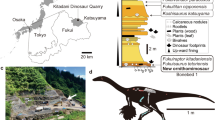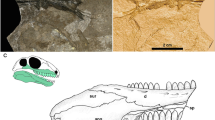Abstract
Primitive ornithomimids, a ubiquitous group of specialized Cretaceous dinosaurs nested within a clade of predominantly carnivorous theropods, are known to have had teeth, whereas derived ornithomimids had an edentulous beak, which has prompted speculation about their dietary habits1. Here we describe two new ornithomimid specimens in which soft-tissue structures of the beak have been preserved. These creatures probably used their beaks to strain food sediment in an aqueous environment, rather than for predation on large animals.
This is a preview of subscription content, access via your institution
Access options
Subscribe to this journal
Receive 51 print issues and online access
$199.00 per year
only $3.90 per issue
Buy this article
- Purchase on Springer Link
- Instant access to full article PDF
Prices may be subject to local taxes which are calculated during checkout


COURTESY OF MIKE SKREPNICK
Similar content being viewed by others
References
Osmólska, H. in Encyclopedia of Dinosaurs (eds Currie, P. J. & Padian, K.) 499–503 (Academic, New York, 1997).
Sternberg, C. A. Can. Field-Nat. 47, 79–83 (1933).
Osmólska, H., Roniewicz, E. & Barsbold, R. Palaeontol. Polonica 27, 103–143 (1972).
Zweers, G. A., Gerritsen, A. F. & van Kraneburg-Voogd, P. J. in Contributions to Vertebrate Morphology vol. 3 (eds Hecht, M. K & Szalay, F. S.) 1–109 (Karger, Basel, 1977).
Goodman, D. C. & Fisher, H. I. Functional Anatomy of the Feeding Apparatus in Waterfowl (Aves: Anatidae) 1–193 (South. Illinois Univ. Press, Carbondale, 1962).
Osborn, H. F. Am. Mus. Bull. 35, 733–771 (1916).
Kobayashi, Y. et al. Nature 402, 480–481 (1999).
Jerzykiewicz, T. & Russell, D. A. Cretaceous Res. 12, 345–377 (1991).
Currie, P. J. & Eberth, D. A. Cretaceous Res. 14, 127–144 (1993).
Eberth, D. A. in Encyclopedia of Dinosaurs (eds Currie, P. J. & Padian, K.) 379–384 (Academic, New York, 1997).
Makovicky, P. J. & Norell, M. A. Am. Mus. Novitates 3247, 1–16 (1998).
Author information
Authors and Affiliations
Corresponding author
Rights and permissions
About this article
Cite this article
Norell, M., Makovicky, P. & Currie, P. The beaks of ostrich dinosaurs. Nature 412, 873–874 (2001). https://doi.org/10.1038/35091139
Issue Date:
DOI: https://doi.org/10.1038/35091139
This article is cited by
-
Subaqueous foraging among carnivorous dinosaurs
Nature (2022)
-
Halszkaraptor escuilliei and the evolution of the paravian bauplan
Scientific Reports (2019)
-
The earliest evidence for a supraorbital salt gland in dinosaurs in new Early Cretaceous ornithurines
Scientific Reports (2018)
-
Functional anatomy of a giant toothless mandible from a bird-like dinosaur: Gigantoraptor and the evolution of the oviraptorosaurian jaw
Scientific Reports (2017)
-
Complex neuroanatomy in the rostrum of the Isle of Wight theropod Neovenator salerii
Scientific Reports (2017)
Comments
By submitting a comment you agree to abide by our Terms and Community Guidelines. If you find something abusive or that does not comply with our terms or guidelines please flag it as inappropriate.



